
The Natural Georgia Series: The Okefenokee Swamp

 |
The Natural Georgia Series: The Okefenokee Swamp |
 |
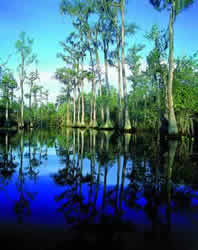
The swamp is relatively low in diversity of plants because of the acid water,
low nutrient levels, and sandy soil. There are no known endemics (species found
only in the Okefenokee Swamp), perhaps due to the young age of the swamp estimated
at less than a million years. Because of the acid water, the swamp is dependent
on physical processes to convert and release nutrients. Water depth and cycles
of flood and drought, known as hydroperiod, are very important, as are UV light
mediated decomposition, and fire. Some scientists are concerned about the upsetting
of these physical processes due to man's control of the swamp's water level
by the construction of a dam, and fire prevention. Approximately 600 species
of plants are found in the Okefenokee swamp.
The dominant tree of the Okefenokee Swamp is the pond-cypress, Taxodium
ascendens , a rot-resistant species recognized by its wide base which emerges
out of the water then quickly tapers to a much narrower trunk. The cypress,
with its branches draped with Spanish moss, creates the mysterious look that
most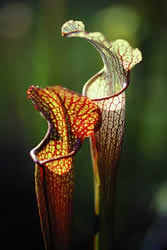 associate with the swamp. Although most of the Okefenokee Swamp's cypress was
harvested in the early 1900s, some giants are still found over 120 feet tall
and older than 400 years.
associate with the swamp. Although most of the Okefenokee Swamp's cypress was
harvested in the early 1900s, some giants are still found over 120 feet tall
and older than 400 years.
A descendant of an early tree species that covered much of North America 70
million years ago, the pond-cypress is a conifer. But unlike pines, spruces
and firs, it loses its needles in the fall. Known to hybridize with its close
relative the bald-cypress, Taxodium distichum , both trees are members
of the redwood family and are not true cypress like white-cedar, juniper, and
redcedar. The two water-loving species are distinguished from each other by
where they are found, the characteristics of their bark, and the shape of their
needles. The pond-cypress is found in lakes and ponds, has thick, 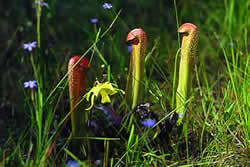 deeply
furrowed bark and closed needles that lie flat, whereas the bald-cypress prefers
the moving water ofstreams and rivers, has shallowly furrowed bark that sloughs
off in thin, flaky scales, and has open needles that fan out from twigs in two
rows. Both cypress have deep, laterally growing roots, adapted for the wet peaty
soil, and a base of knees which give the treeadditional stability and may play
a role in providing oxygen to the tree in the wet environment.
deeply
furrowed bark and closed needles that lie flat, whereas the bald-cypress prefers
the moving water ofstreams and rivers, has shallowly furrowed bark that sloughs
off in thin, flaky scales, and has open needles that fan out from twigs in two
rows. Both cypress have deep, laterally growing roots, adapted for the wet peaty
soil, and a base of knees which give the treeadditional stability and may play
a role in providing oxygen to the tree in the wet environment.
Because of its decay resistance, the cypress has many practical uses involving
exposure to weather or contact with soil, and is a prized lumber for interior
trim. More than 400 million board feet of Okefenokee cypress were cut from 1909
to 1927. A testament to cypress's durability is found in theswamp, where many
old abandoned train pilings are found still standing in rows like silent soldiers
marching into the swamp.
Other trees found in the swamp include slash pine, Pinus elliotii ;
blackgum, Nyssa sylvatica ; Ogeche lime, Nyssa ogeche ; loblolly-bay,
Gordonia lasianthus; Swamp-bay, Peresa palustris; sweet-bay, Magnolia
virginiana ; water ash, Fraxinus caroliniana ; and others.
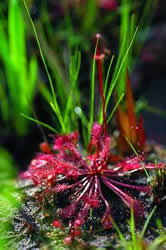
Because of the swamp's phosphate-and-nitrogen poor soil, the Okefenokee is
home to many fascinating "meat-eating" plants. Decay is slow in the
acid soil, therefore little nitrogen is available for the roots of the plant.
Carnivorous plants have adapted to these conditions by developing a variety
of strategies for trapping and ingesting insects - an excellent source of protein
in the swamp. One wonders what the swamp would be like if the carnivorous plants
grew as large as the cypress trees.
Some of the most distinctive looking plants in the swamp are the pitcher plants,
found growing in clumps around the swamp. The Sarracenia genus of plants
has eight species, seven of which are found only in the southeastern U.S. The
pitcher plants hold small pools of water inside their long stalks, or "pitchers."
Insects are attracted inside the pitchers, sometimes by the odor of decay or
sweetness, and are forced downward by pointing hairs inside thelining of the
plant. Trapped inside the pitcher's small pool where a narcotic helps drown
them, bacteria then decomposes the soft parts of the insect, and enzymes convert
the protein into usable nitrogen. Slicing open the tube of the pitcher will
reveal the black skeleton remains of many insects. Three varieties of pitcher
plants are found in the swamp: the golden trumpet pitcher, Sarracenia
flava ; the hooded pitcher plant, Sarracenia minor; and the parrot
pitcher plant, Sarracenia psittacina. The golden trumpet pitcher is recognized
by its more open top. Thehooded pitcher has a definite curving top, sometimes
with small, transparent windows on the back of its hood which help trap insects
inside the pitcher. Flying insects are attracted to the windows where they spend
their last hours. The parrot pitcher has smaller, reclining pitchers. All havea
remarkable drooping flower that helps attract insects.
A variety of sundews use a sticky substance to catch smaller insects such
as gnats. The round-leaved sundew, Drosera rotundifolia , has reddish
leaves with long, stringy red hairs covered with glistening droplets of a sticky
substance that makes the plant a type of natural flypaper. After the insect
becomes stuck to the plant, the leaf slowly closes to enclose and digest the
insect.
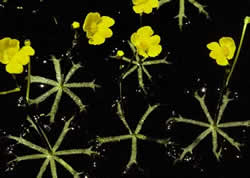
Butterworts and bladderworts are classified in the bladderwort family, Lentibulariaceae
, but use very different strategies for eating insects. The yellow butterwort,
Pinguicula lutea , uses a sticky substance on its leaves to trap and
digest insects. The small plant is recognized by its solitary yellowflower growing
out of a basal rosette of yellow-green, sticky leaves. There are also purple
flowering butterworts in the Okefenokee. The swollen bladderwort, Utricularia
inflata , is an aquatic plant, that eats tiny aquatic creatures such as
insect larvae, protozoa, and crustaceans. The plant is recognized by yellow
flowers on a long stalk growing out of a center of feathery leaves which look
like spokes on a wagon wheel. The leaves are made up of small air sacs or bladders.
The bladders have a small opening and a trap-door device that is tripped by
entering insects preventing their escape. There are five species of bladderworts
in the swamp.
Golden club, Orontium aquaticum , is one of the more common aquatic
plants of the Okefenokee prairie, and one of the more beautiful in the spring.
An emergent perennial, it has minute yellow flowers clustered on a golden yellow
club-like spadix. Below the yellow tip the plant is white then red. The 10-inch,
dark green, oblong-pointed leaves have a waxy coating that easily repels water
and earns the plant the swamp nickname of "neverwet." It is also considered
the "Herald of Spring," because whenthey emerge, it is spring in the
swamp.
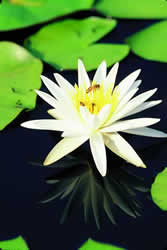
Probably the most dramatic and common flower found in the Okefenokee is the
fragrant water lilly, Nymphaea odorata. Found floating on top of the
reflective, black swamp water in large communities, the plant consists of white
flowers with yellow stamens and round, flat, floating leaves that are shiny
green on top and purplish-red underneath. The stomata or tiny openings on the
leaf surface through which carbon dioxide and other gases pass into the plant
are located on the upper leaf surface instead of underneath like most land plants.
The leaf stalk has four main channels for the movement of gases from the leaves
to the large stems or rhizomes. The rhizomes scare tourists who believe them
to resemble some undiscovered swamp snake and frequently foul the props of outboard
boat motors. When the flower fades, the stalk retreats into the water submerging
the hard-cased fruit while the seeds mature. When the case opens, the seeds
float free until they become waterlogged, sink, and take root.
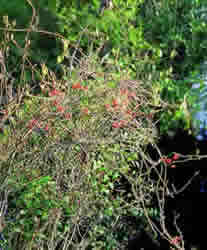
The green-briar, Smilax walteri, is a vine with flowers with a putrid
smell that put it in the Smilax or carrion flower genus. It's bad-smelling flowers
attract carrion flies, which act as pollinators. The green-briar is the only
cat-claw briar species that doesn't have thorns. It's red berries, which drop
and float, are popular with waterfowl.
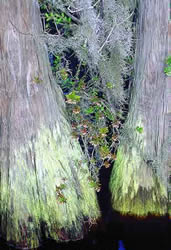
Climbing heath, Pieris phillyreifolia, is one of 2,500 species in the
heath family, Ericaceae , consisting of shrubs or woody perennial herbs, often
with showy flowers. Many ornamentals, such as rhododendrons and azaleas, come
from this family as do several edible fruits such as blueberries, huckleberries,
and cranberries. Heaths thrive in acid soils in temperate regions. The climbing
heath likes to grow under the bark of cypress trees and has tiny, tube-like
white flowers.
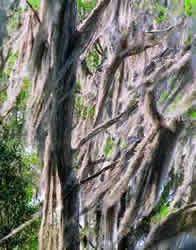
Spanish moss, Tillandsia usneoides, is one of the distinctive plants
of the Okefenokee, adding to the swamp's mysterious allure. Spanish moss is
not a true moss, but an air plant or epiphyte. Not a parasite of the tree, it
gets nourishment from the sun, airborne nutrients, and foliage of the host tree.
Flowers on the plant are small, green, and rarely seen.
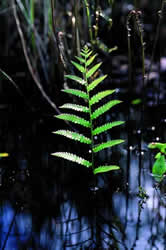
The Virginia chain fern, Woodwardia virginica, is one the most primitive
plants in the swamp. Growing two-to-four feet tall, straight out of the water,
the spore cases form chains thus giving the plant its name.
The Okefenokee is a southern blackwater swamp which is defined by its tea-colored,
acidic water. Helping to create this brew is a mix of decaying organic matter,
called peat. Peat is easily found in floating peat batteries, which according
to one study are 80 percent decaying water lillies and cypress. Standing on
one of these floating islands is like standing on a waterbed, and is thought
to be the origin of the Creek Indian name O-ke-fin-o-cau: "Land
of the Trembling Earth."
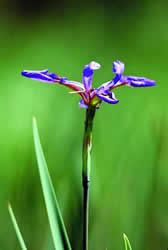
The southern blue-flag, Iris virginica, is a beautiful purple-blue flower found in the swamp. A showy native iris of southern wetlands, the extremely poisonous rhizome was dried and used in small amounts as a diuretic and cathartic by Indians.
An estimated 425 species of vertebrate animals have been found in the Okefenokee,
including 39 fishes, 37 amphibians, 64 reptiles, 235 birds, and 50 mammals.
Eleven species are threatened or endangered. With more than 50 percent of the
vertebrate species, the Okefenokee's birds are the easiest to see and experience.
There is an especially high diversity of reptiles. The insect life is abundant,
as a visitor during June will attest, and an important contributor to the cycling
of nutrients. An estimated 12 to 40 percent of the forest canopy is consumed
by insects, primarily butterflies and moths.
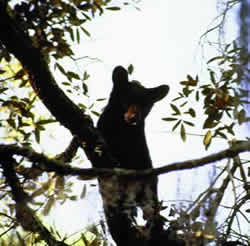
The Okefenokee's largest mammal is the Florida black bear, Ursus americanus
floridianus, and reportedly can grow to 400 pounds, though they generally
average approximately 150 pounds, smaller than the average Appalachian bear.
This subspecies or "hog bear" as locals call it, has a healthy population
of approximately 500 animals, equivalent to the numbers found in the Great Smoky
Mountain National Park. Populations have grown to this historic high level after
the state began protecting the bear statewide in 1972. Today, there is a six-day
bear hunting season and approximately 50 percent of all bears killed in Georgia
are in Charlton County near the swamp. Okefenokee pioneers held black bears
in low regard and tried to hunt them into extinction -- not because they found
them threatening but because the bears threatened the swampers' survival by
attacking and consuming the settlers' hogs, cows, chickens, honeybees, corn
fields, fruit trees, and grape vines. Today, there's no swamper property to
protect, so the bears have made a comeback and are found mainly around the Trail
Ridge section of the swamp. There are concerns about poaching of bears for the
bogus use of bear parts in exotic medicines in the Orient.
Black bears are opportunistic feeders, and will eat berries, reptile eggs,
yellow jacket nests, insects, grasses, and palmettos, among other items. The
bears are mainly nocturnal and have a home range of approximately 8-10 square
miles. If you hear a big crashing sound in the woods you are probably hearing
a bear.
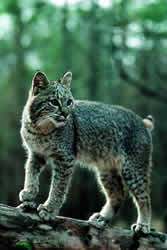
The bobcat, Felis rufus, is widespread and plentiful in the Okefenokee,
which has one of the best populations in the state. Bobcats range from the dry
sandhill communities along the eastern boundaries of Trail Ridge near Folkston,
to the low wetlands surrounding "the pocket" and Jones Island on the
southwestern perimeter of the Okefenokee. Bobcats are illusive and retiring
creatures and normally are only seen at night, but increasing populations in
the swamp have made daytime observations more common. Floyds Island, in the
Okefenokee interior, houses one of the greatest concentrations of wild bobcats
in any wildlife refuge in the U.S. Here it is not uncommon to see one of these
wild creatures creeping within a few meters of a campsite.
Bobcats, unique to North America, get their name from their stubby, or "bobbed"
tail. The bobcat eats mice, shrews, rabbits, wild turkey, and other mammalian
prey and mates in the spring, producing a litter of two to four kittens in late
April early May.
The raccoon, Procyon lotor, is the masked bandit of the swamp. If any
mammal deserves to wear a facial mask of a midnight thief, the raccoon is doubtlessly
the prime candidate. These jolly creatures have earned their place in Okefenokee
folklore by chewing on hunting dogs, invading corn fields, stealing meat from
the smoke house, eating grapes from the arbor, killing chickens, and creating
mischief every chance they get. Campers should be alert that raccoons are not
only "cute" but are also intelligent, and can crack a camper's cooler
in less than five minutes. The raccoon is the most abundant fur-bearing animal
in the swamp, and it eats berries, frogs, fish, reptile eggs, and anything else
it can get its dexterous hands on.
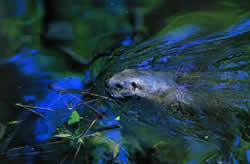
The river otter, Lutra canadensis, is found along the main waterways
of the Okefenokee, in the open water of the prairies and in the Suwannee and
St. Marys rivers. The otter is a marvelous, graceful swimmer that feeds mainly
on fish, but will supplement its diet with just about anything including crustaceans,
small mammals such as mice, and snakes. The Okefenokee settlers made household
pets of the playful, sociable otter. Oldtimers tell stories about how otters
would eat from their dinner table and play with the children and family housecat.
Sought by trappers for their valuable fur, their numbers once dwindled but have
made a comeback with a crash in the market for their fur. Today, the otter's
main enemy is probably the alligator. You may find otters by looking for mud
slides on river banks where otters have been amusing themselves.
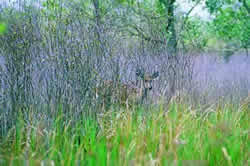
White-tailed deer, Odocoileus virginianus, are now common in Georgia,
and are often observed in the Okefenokee. The deer frequent a wide variety of
habitats in the swamp, and it is exciting to see onewading in the water while
foraging on berry-producing plants. Another good time to see deer is early or
late in the day as one travels the roads into the Suwannee Canal Recreation
Area or Stephen C. Foster State Park. With the general demise of the red wolf,
Canis rufus, and panther,Felis concolor, the white-tailed deer
have no natural enemies other than man. This has led some to propose the return
of red wolves and panthers to the wildlife refuge to control deer populations.
The last wolves were reported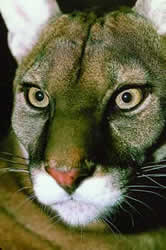 on Floyds Island in 1921, whereas observations of panthers occur fairly frequently
with no corroborating evidence such as tracks, photos, or the animals themselves.
In a study several years ago, mountain lions, Felis concolor, with radio
collars were released in the park to see how they would adapt to the swamp environment.
Researchers found that the animals had no trouble traveling through the refuge.
One animal was shot by a poacher. When the study was completed, the animals
were picked up.
on Floyds Island in 1921, whereas observations of panthers occur fairly frequently
with no corroborating evidence such as tracks, photos, or the animals themselves.
In a study several years ago, mountain lions, Felis concolor, with radio
collars were released in the park to see how they would adapt to the swamp environment.
Researchers found that the animals had no trouble traveling through the refuge.
One animal was shot by a poacher. When the study was completed, the animals
were picked up.
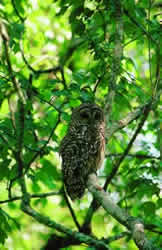
The barred owl, strix variar, has a loud barking call that will startle
you into looking for the shy bird. The owl is usually found sitting back in
a tree's foliage in a thick grove of a lowland forest. The owl is recognized
by feathered bars on its neck and an absence of feather tufts around the ears.
A nocturnal bird, like most owls it rests during the day, coming out at night
to hunt frogs, rodents and birds.
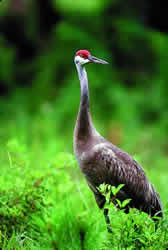
Florida naturalist Archie Carr wrote that there are only three great animal
voices remaining in the southeastern United States: the "jovial lunacy
of the barred owl ... the roar of the alligator ... (and) the ethereal bugling
of the sandhill crane." All three can be heard in the Okefenokee, and all
three can stop you in your tracks. The inexperienced can probably imagine the
hoot of the owl and the dinosaur rumble of the alligator, but the call of the
sandhill crane is unlike anything you've ever heard. Once you've heard it, I
guarantee that you will never forget the voice of the "watchmen of the
swamp." Sandhills, Grus canadensis, are the largest birds in the
swamp, standing nearly four feet tall, with a 7 foot wingspan, gray body and
red forehead. You will usually hear them before you see them, as they blend
into the landscape very well. The Okefenokee has populations of sandhills that
spend their entire life in the swamp. The sandhill cranes mate for life and
nest in open places where treesdon't block their keen vision. The are best viewed
on the eastern side of the Okefenokee at the Suwannee Canal Recreation Area.
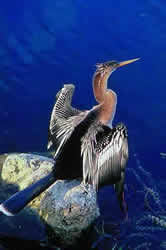
The anhinga, anhinga anhinga, is also called the water turkey and snake
bird, because of its turkey-like tail and snake-like neck. The anhinga feeds
by swimming under the surface of the water and spearing fish with its sharp,
yellow beak. Because the wings of this water bird do not contain oil glands
to keep them sufficiently dry for flight, the anhinga is frequently seen perched
on a branch or stump with its beautiful wings outstretched. On dark, cloudy
days, anhingas instinctively avoid the water. Their unmistakable flight pattern
is flap, flap, flap, flap, and glide.
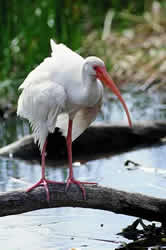
The white ibis, Eudocimus albus , with its orange curved bill and
orange legs, is the most commonly observed white wading bird in the park. The
ibis congregates in flocks and likes to perch at the very top of trees. Found
in the shallow prairies, they move as they feed, using their curved bills to
probe the mud for insects and crayfish. During flight, their black wing tips
become obvious, and their wing beat is much more rapid than other white wading
birds. According to Dr. Bill Cribbs, "this bird was one of the favorite
game birds of early Okefenokee settlers, and it was as welcome on their table
as a chicken."
The great egret or American white egret, Casmerodius albus , was almost
pushed into extinction by turn-of-the-century market hunters and European fashion
mavens, who prized the bird's beautiful white feathers for use in women's hats.
Conservation efforts by groups such as the National Audubon Society (which was
established specifically to save the great egret and snowy egret) helped protect
the bird, one of America's finest herons. It is distinguished from other white
wading birds by its yellow beak and black legs. Like the great blue heron, the
great egret is a solitary feeder, seen standing motionless as it stalks fish,
frogs, snakes, and crayfish. Locals call the great egret a "scoggin"
or "plume bird."
The Prothonotary warbler, Protonotaria citrea , is a characteristic
bird of southern swamplands, where its bright, golden-orange plumage is conspicuous
in the dark, cypress swamps. Called the "flame bird"of the swamp,
the prothonotary has a loud, ringing "sweet-sweet-sweet-sweet-sweet"
song. It is unusual among warblers in that it nests in cavities in trees, and
has been found nesting on the refuge. The family of warblers has the highest
number of bird species found in the swamp with 32.
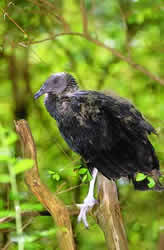
When cartoonists draw caricatures of swamps, they inevitably perch a vulture
in a mossy snag of a dead cypress tree. Vultures are common and nest in the
Okefenokee swamp, including the turkey vulture, cathartes aura , and
the black vulture, Coragyps atratus . These birds have a famous preference
for dead meat, and where they are seen circling is evidence of a fresh, dead
animal. The turkey vulture is the largest of the two, with black wings. The
smaller black vulture, with white patches near its wing tips, is more aggressive
than the turkey vulture and will drive it away from a carcass. Turkey vultures
locate carrion by smell, and black vultures by sight. Both birds are found perching,
or soaring high overhead on thermals.
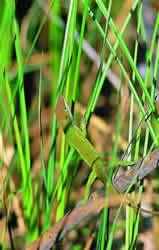
Called the "swamp chameleon," the green anole, Anolis carolinensis
, can change color between greenand brown. It has a pink throat fan and
grows from five to eight inches long. A member of the iguana family, the adults
prefer shaded perches and the young prefer sunny locations close to the ground.
The most abundant lizard of the south, they mate from March to September, and
females can lay a single egg every 14 days, with incubation five to seven weeks.
Anoles slowly stalk their prey of flies, beetles, spiders, moths and other insects.
Anoles are the largest group of reptiles in the Western Hemisphere, with more
than 200 known species, but only the green anole is native to North America.
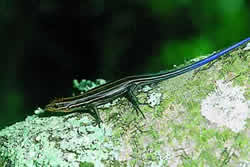
The southern five-lined skink, Eumeces inexpectatus , and its close
relative, the five-lined skink, Eumeces fasciantus , are both commonly
observed sunning themselves on the boardwalks of the refuge. Skinks are lizards,
not salamanders as many mistake them. The two species are recognized by their
five, beautiful yellow stripes and bright blue tales in the juveniles. Adults
lose much of the coloration of their stripes and their tales are not as blue.
The two species are distinguished from each other by the scales on the underside
of their tales. The five-lined has one row of broader scales, whereas the southern's
scales are all the same size. The tail of the skink has fracture planes, allowing
it to break off easily when grasped by a predator. The tail is vividly colored
to draw the attack away from thebody. There are five species of skinks in the
refuge and to identify them, you have to capture them. Don't grab a skink by
the tail because first, you won't capture the skink, and second, the escaping
skink's survival chances are greatly reduced because it won't have its decoy
tail when it needs it for a predator. Cats that eat the southern five-lined
have been known to lose their sense of balance or develop paralysis requiring
veterinary attention.
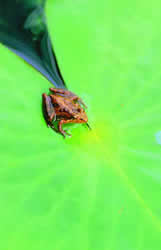
What would a trip to a swamp be without seeing a frog on a lilly pad or hearing
the grunt of the bullfrog? Frequently heard and less often seen, the more than
20 species of frogs and toads in the Okefenokee make their presence known by
their loud chorus of voices. Like their name suggests, the voice of the Southern
spring peeper, Hyla crucifer bartramiana , is an early announcement
of spring in the South. Usually a brownish or tan color, the inch-long, nocturnal
spring peeper is recognized by a dark X on its back 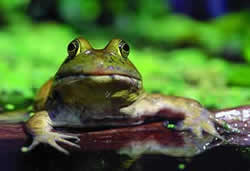 (hence
crucifer - - cross). The Florida cricket frog, Acris gryllus dorsalis ,
is a tiny frog that many mistake as a juvenile version of other species. It
has a dark triangle between the eyes, a rapid, cricketlike voice, and is a good
jumper. Active during the day, the "swamp" cricket frog prefers the
margins of swamps, roadside ditches, and lakes, and is many times the creature
jumping into the water just before you as you walk along the water's edge. The
bullfrog, Rana catesbeiana , is the largest frog in the Okefenokee,
and the largest frog in North America, growing to eight inches. The bullfrog's
legs are so large that they are raised commercially and sold as meat in the
restaurant trade. A nocturnal amphibian, the bullfrog has been known to eat
small birds and young snakes, but it usually preys on insects, small fish, crayfish,
and other frogs. The bullfrog's coloring varies, but it is one of the more beautiful
animals with its dark green mottling on top and lighter coloring underneath.
It's voice is usually described as "jug-o'-rum."
(hence
crucifer - - cross). The Florida cricket frog, Acris gryllus dorsalis ,
is a tiny frog that many mistake as a juvenile version of other species. It
has a dark triangle between the eyes, a rapid, cricketlike voice, and is a good
jumper. Active during the day, the "swamp" cricket frog prefers the
margins of swamps, roadside ditches, and lakes, and is many times the creature
jumping into the water just before you as you walk along the water's edge. The
bullfrog, Rana catesbeiana , is the largest frog in the Okefenokee,
and the largest frog in North America, growing to eight inches. The bullfrog's
legs are so large that they are raised commercially and sold as meat in the
restaurant trade. A nocturnal amphibian, the bullfrog has been known to eat
small birds and young snakes, but it usually preys on insects, small fish, crayfish,
and other frogs. The bullfrog's coloring varies, but it is one of the more beautiful
animals with its dark green mottling on top and lighter coloring underneath.
It's voice is usually described as "jug-o'-rum."
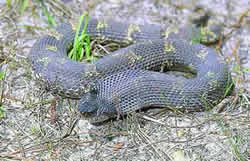
Found in the drier, sandier parts of the refuge is the Easternhognosed snake,
Heterodon platyrhinos . Sufficient to identify the hognosed snake is
its unforgettable and unique behavior. The hognose will puff out its neck like
a cobra, hiss, and strike without biting. When further molested, the hognose
will roll over on its back, open its mouth, convulse a few times and play dead.
Turn the snake right side up, the snake will twist again to belly up position.
The snake has many nicknames, such as "hissing sand snake," "puff
adder," and "blow viper," but goes by hognosed snake because
of its upturned snout. The Eastern species' skin pattern is spotted, and the
coloration is widely variable (unlike the Southern hognose, also found in the
refuge, which is fairly constant), with dark patches on a yellow, brown, olive,
gray, orange, or red snake. The Eastern grows to more than three feet in length,
whereas the Southern species is a smaller, foot- to two-foot-long snake.

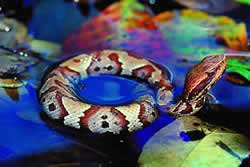
The Okefenokee has 37 species of snakes, but the cottonmouth snake, Agkistrodon
piscivorus , and Eastern diamondback rattlesnake, Crotalus adamanteus
, are the most feared by man. The cottonmouth has a venomous bite and tends
to hold its ground more readily than a water snake. When aroused, the cottonmouth
will threaten an intruder by exposing the light "cotton" lining of
its mouth and mimic a rattlesnake by shaking its tail. Its bite is more serious
than the copperhead's, and can be fatal. It is distinguished from other water
snakes by its vertical pupil and pit below its eye, and its method of swimming
with its head out of the water. You do not want to disturb or handle this snake.
The Eastern diamondback, the largest rattlesnake in the world, is also best
left alone because of itspoisonous and possibly fatal bite. The Eastern diamondback,
known to grow to eight feet, prefers dry pinelands and palmetto flatwoods that
surround the swamp. The snake is recognized by, of course, its rattles, its
distinct colored diamond shapes on its skin, its large head and heavy body.
Some diamondbacks will wait until the intruder is nearly upon it before it rattles.
Others will rattle when an intruder is 30 feet away. The diamondback has been
persecuted by man for "round-ups" and fear, and is becoming less common
throughout its range.
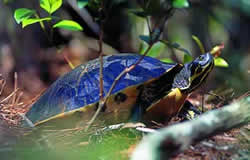
The Florida cooter, Pseudemys floridana floridana, is a very shy turtle
that is difficult to catch in the refuge. Usually about a foot long,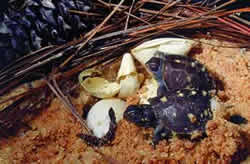 the Florida cooter has yellow stripes on its head, an unmarked plastron, and
donut-shaped marks on the underside of its marginals. It is frequently seen
basking, butthis turtle is extremely wary and will slide into the water before
you get too close. The Florida cooter has an unusual habit during nesting which
it shares with only two other species of turtles in the world. Most turtles
dig one nest in the ground, lay eggs in the the hole, and cover it with dirt.
The Florida cooter digs one main nest, lays most of its eggs in this nest, pauses,
and digs two side nests and places a few eggs in each of these. The reason for
this behavior is unclear to scientists. This turtle lives in the coastal plain
of the U.S.
the Florida cooter has yellow stripes on its head, an unmarked plastron, and
donut-shaped marks on the underside of its marginals. It is frequently seen
basking, butthis turtle is extremely wary and will slide into the water before
you get too close. The Florida cooter has an unusual habit during nesting which
it shares with only two other species of turtles in the world. Most turtles
dig one nest in the ground, lay eggs in the the hole, and cover it with dirt.
The Florida cooter digs one main nest, lays most of its eggs in this nest, pauses,
and digs two side nests and places a few eggs in each of these. The reason for
this behavior is unclear to scientists. This turtle lives in the coastal plain
of the U.S.
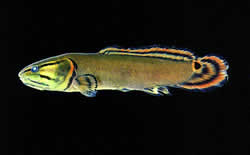
The bowfin, Amia calva , is a fascinating fish that is a legend among
fishermen. So much so, locals have given it many names such as mudfish, dogfish,
black fish, shoepick, cotton fish, grinnel, scaly cat, spottail, Florida trout,
Cypress trout and others. The bowfin is like a swimming fossil: it is the last
remaining survivor of an ancient family of highly predaceous fishes. Relatives
of the bowfin were abundant in marine environments during Jurassic and Cretaceous
times approximately 150 million years ago, and are found represented in fossils
from those times. The bowfin has a gular bone, a flat plate on the floor of
the mouth between the lower jaws, not found in any ofNorth America's freshwater
fishes but found in some marine fishes such as the tarpon. The bowfin spawns
in spring in shallow waters where the male clears vegetation and excavates a
shallow nest. After spawning, the male protects the nest and guards the young
for several weeks after they've hatched. Bowfins are considered transitional
fishes, developed somewhere between gars and bony fishes. With partially developed
air breathing devices, the bowfin can survive a long time out of water. They
will gulp air into their swim bladders, which are equipped with blood vessels
and can serve as a primite lung. Fishermen should beware of the fish's sharp
teeth. Bowfins are common around the sill and below the sill in the Suwannee
River.
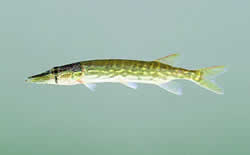
The chain pickerel, Esox niger , also called a jackfish, black pike,
green pickerel, green pike, and justjack by swampers, is an exciting fish that
loves to jump, and more than one fisherman has beensurprised by a slap in the
face by a flying jackfish. A solitary fish, it prefers quiet waters with heavy
vegetation, where it stalks its prey. The chain pickerel is a popular gamefish
in the northeast and is caught by ice fishermen during the winter, but the world
angling record for the chain pickerel was set in Georgia in 1961 at nine pounds,
six ounces.
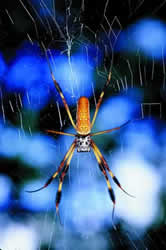
A beautiful orb-weaving spider, the golden-silk spider, Nephila clavipes , is found in the refuge. The female golden-silk spider has a one-inch long golden body, and golden legs with conspicuous tufts of black hair on the first and last pairs of legs. The male, sometimes located nearby on the web, is much smaller - only an eighth of an inch and drab colored. Also known as the calico spider, during the day the female is found perched head downward near the mesh-like center of the two- to three-foot web. Some orb-weavers replace their web every day, but the golden-silk spider redoes only one side a day and never the whole web. Sometimes, the spider can be found in large groups in shaded woodlands near water and swamps.
Read and add comments about this page
Go back to previous page. Go to Okefenokee Swamp contents page. Go to Sherpa Guides home.
[ Previous Topic | Next Topic ]